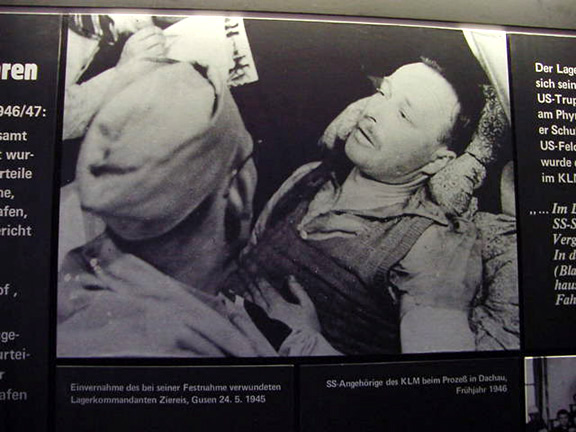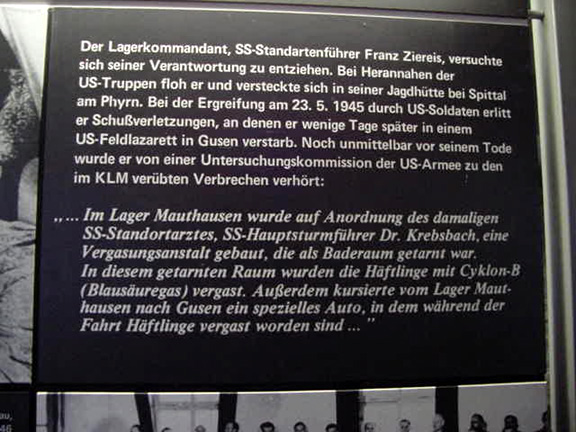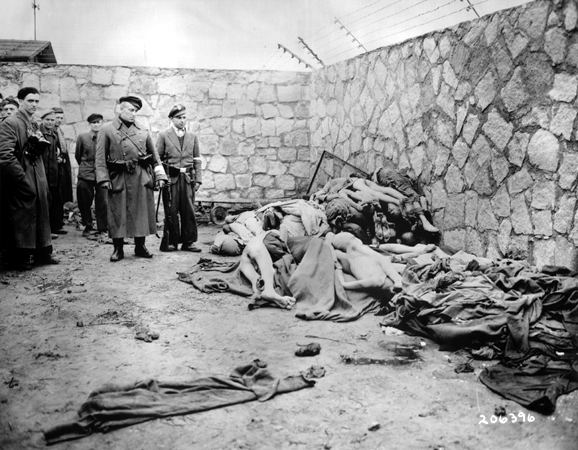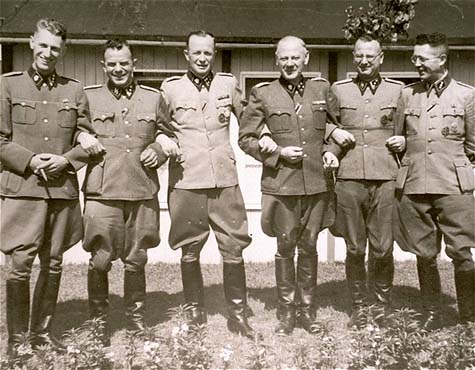The confession of Franz Ziereis, Commandant of the Mauthausen concentration camp The photo above shows a display board in the Museum at the former Mauthausen concentration camp. According to the Mauthausen Museum, this photo was taken on May 24, 1945 and it shows Mauthausen Commandant Franz Ziereis as he allegedly gave his deathbed confession. According to Hans Marsalek, a Communist political prisoner in the camp, who wrote an affidavit ten months later, in which he quoted from the confession from memory, Ziereis gave his confession, during 6 to 8 hours of interrogation on the night of May 22nd and 23rd, 1945 at the Gusen sub-camp of Mauthausen. Marsalek's affadavit was entered into the Nuremberg International Military Tribunal and was used as evidence during the trial of Ernst Kaltenbrunner, although Hans Marsalek refused to take the witness stand. Note that Ziereis has been propped up for the photo, and a harness around his chest, with straps over his shoulders, appears to be holding his body upright. An unidentified man wearing an American Army cap is sitting very close to Ziereis while the arm and hand of another man can be seen in the upper left hand corner. Everything has been carefully posed to show Ziereis as he allegedly makes his death-bed confession, but notice that the three elements of the photo do not match; it looks like three separate photos that have been put together. This is a flash photo but there is more light on the arm in the background than on the soldier in the foreground. It appears that Ziereis was dead when the photo was taken.  The photo above, taken in the Mauthausen Museum, shows a display board right next to the photo of Franz Ziereis, which is shown at the top of this page. The first paragraph on the sign in the photo states that Ziereis was shot on 23.5.1945 and that he died several days later in a U.S. Field Hospital in Gusen. However, according to Marsalek's affidavit, Ziereis was shot on May 22, 1945. The second paragraph on the display board shown in the photo above is a quote from the alleged confession of Franz Ziereis in which he said that a gas chamber, disguised as a bathroom, was built at Mauthausen on the order of Dr. Krebsbach; the prisoners were gassed with Cyklon-B. Besides this, there was a special vehicle which traveled between the Mauthausen main camp and the Gusen sub-camp, in which prisoners were gassed along the way. In the official version of the story, Ziereis died in an American Army field hospital at the Gusen 1 sub-camp, 6 kilometers west of the Mauthausen main camp, but not before he talked for 6 to 8 hours, confessing to the deaths of millions of prisoners, including the killing of prisoners in the gas chamber at Mauthausen and the castle at Hartheim. In a sworn affidavit, dated April 8,
1946, that was entered into the Nuremberg IMT as document 3870-PS,
Hans Marsalek, a prisoner who worked as a clerk at the Mauthausen concentration camp, wrote the following in German, which was translated into English and entered into the IMT as Document 3870-PS:
AFFIDAVIT OF HANS MARSALEK "I joined the SS on 30 September 1936 as a training specialist with the rank of Obersturmfuehrer (Lieutenant). I was assigned to the 4th SS Regt at Oranienburg and was transferred to Mauthausen on 17 February 1939, with the rank of Hauptsturmfuehrer (Captain) and successor to the former Commandant of the camp. SS Fuehrer Saurer. According to the testimony of the "Corpse Carriers" of that time, the former prisoners Albert Tiefenbacher, present address Salzburg; and Johann Polster, present address Pottendorf near Wiener Neustadt, Austria; about fifteen prisoners of the arrest class were selected by Unterscharfuehrer Winkler, in order to show Dr. Kaltenbrunner three ways of extermination, by a shot in the neck, hanging, and gassing. Women whose hair had been cut were among the executed and they were killed by shots in the neck. Above-mentioned "Corpse Carriers" were present at the execution and had to carry the corpses to the Crematorium. Dr. Kaltenbrunner went to the Crematorium after the execution and later went into the quarry. U.S. Associate Trial Counsel Col. John Harlen Amen read parts of the Marsalek affidavit on April 12, 1946 at the Nuremberg IMT, including the part pertaining to an order allegedly given by Ernst Kaltenbrunner to blow up all the prisoners at the Gusen camp. Ernst Kaltenbrunner was on trial at Nuremberg, charged with Crimes against Humanity which included the gassing of prisoners, to which Ziereis had confessed, according to Marsalek's affidavit. Kaltenbrunner objected to the reading of the affidavit, saying: This Hans Marsalek whom, of course, I have never seen in my life, had been an internee in Mauthausen as were the two other witnesses. I have briefly expressed my views as to the value of a statement concerning me from a former concentration camp internee and my inability to speak face to face with this witness who now confronts me, and my application will be made through my counsel. I must ask here to be confronted with Marsalek. Marsalek cannot know of any such order. In spite of that he states that he did. The "order" that Kaltenbrunner referred to was the alleged order to kill all the prisoners just before the Americans arrived. Kaltenbrunner's request to be confronted with Marsalek was denied and Marsalek never took the witness stand at Nuremberg. The Commander of the 11th Armored Division was Richard R. Seibel, who arrived at Mauthausen some time in April 1945, before the camp was officially liberated, and stayed there for 35 days before being assigned to duty in the Austrian Alps, according to the United States Holocaust Memorial Museum. Two American field hospitals were brought in, according to the USHMM. The caption on the photo at the top of this page says that the photo on display was taken on May 24, 1945 at the Gusen camp. The soldier in the photo is not identified, but allegedly Col. Richard R. Seibel, the commander of the 11th Armored Division was present when Commandant Franz Ziereis was questioned by Hans Marsalek. Col. Seibel did not testify at the Nuremberg IMT, nor did he sign his name as a witness to the confession of Ziereis. In the upper left hand corner of the photo at the top of this page can be seen what looks like the sleeve of a striped prison uniform on the arm of a person who is taking notes, possibly Dr. Koszeinski, a prisoner whom Marsalek alleges was present, or Marsalek himself. The name of the photographer is not mentioned on the display, but Francois Boix, a prisoner who worked in the photography department at the main Mauthausen camp, was allegedly present when Ziereis made his confession. Boix worked in the darkroom at Mauthausen and had the means and the opportunity to put three photographs together to make a fake photo. Boix testified at the Nuremberg IMT that Mauthausen was an extermination camp where the only way out was through the chimney, and that there were gas chambers there, but he was not asked about the confession of Franz Ziereis. The Army Signal Corp photo below shows Boix at the main Mauthausen camp with a camera around his neck. At the Nuremberg IMT, Boix identified a photo of Ernst Kaltenbrunner, which proved that Kaltenbrunner had visited the camp.  In his alleged 6-to-8-hour confession, which was written up from memory ten months later by Hans Marsalek, Ziereis named Dr. Krebsbach as the man who was responsible for setting up the gas chamber at Mauthausen. Ziereis also allegedly confessed that he personally drove a gas van between Mauthausen and Gusen, killing prisoners with carbon monoxide on the way, and that between 1 million and 1.5 million prisoners were gassed in the 192-square-foot gas chamber at Hartheim Castle. In the photo below, taken in the camp at Mauthausen, Commandant Franz Ziereis is the third man from the left. Sturmbannführer Eduard Krebsbach, the camp doctor at Mauthausen until June 1943, is the man standing to the left of Ziereis in the group photo.  In his book entitled "The 186 Steps," Christian Bernadac gives information which disputes the official version; Bernadac claims that Ziereis was taken prisoner and interrogated by two prisoners before he was shot. Bernadac quotes the following information given by Razola and Constante, two Spanish prisoners at Mauthausen, regarding the death of Ziereis: Commander Ziereis, recognized in spite of the fact that he was wearing civilian clothing, was taken prisoner and led to the camp where his interrogatory was conducted by (Hans) Marsalek and (Francisco) Boix. There was nothing courageous in his attitude. He was quibbling and sniffing, and argued that he was not responsible, and that all he did was carry out the orders of his government. He was executed by an American officer of Cuban origin who took the responsibility of seeing that justice was done and in this way made it impossible for the American authorities to intervene against the deportees (prisoners). A variation in the story of the death of Franz Ziereis, quoted below, was written by Robert Whealey in a recent article entitled "The Spanish Holocaust and the Cover-Up that Lasted a Generation" which was published in 2008 on the History News Network web site: The last days of SS Colonel Ziereis may be typical. On the evening of 23 May in the village of Spital, Chief Warrant Officer Walter S. Kobus (US Army) with three G.I.s and two ex-prisoners, a Spaniard and a Czech, captured Ziereis as he was preparing for suicide with a pistol. He bungled the attempt. Taken back to KL (Konzentrations Lager) Mauthausen, he was interrogated by three other ex-prisoners. Ziereis blamed his actions on his superiors: Obergruppenfuehrer (Four Star General) Oswald Pohl, Himmler and Hitler. The Czechs and Spaniards thought the US 11th Armored Division, then in charge of the stinking camp, would somehow allow Ziereis to go free, so they shot him in a trap which would allow him to believe that he could escape. The wounded Ziereis was taken by the U.S. Lt. Colonel in charge to a US field hospital where he died the next day. Ziereis's son witnessed the final hours and spat on his dying father. The reason that the son of Ziereis allegedly spat on his dying father might have been because his father had given him a rifle for his tenth birthday. Richard Sonnenfeldt, a 22-year-old Jew, who was the chief American interpreter at the Nuremberg IMT, wrote the following in his book entitled "Witness to Nuremberg: The Chief American Interpreter at the War Crimes Trial": One visit to Austria took us to the concentration camp at Mauthausen. We were seeking witnesses to prove that Ernst Kaltenbrunner, the senior surviving SS officer who was likely to be a defendant at Nuremberg, had personally observed the butchery going on at Mauthausen during repeated visits. Though "only" a few hundred thousand had been killed at Mauthausen, as compared to millions at Auschwitz, this concentration camp was not just an ordinary death factory. Mauthausen was infamous for the extreme cruelties and satanic tortures invented and practiced by Franz Ziereis, it's commandant. Ziereis himself had died before we arrived, wounded mortally while trying to escape. But we did talk to Ziereis's wife and teenage son. Although I have forgotten the son's name, my conversation with him is burned in my memory. He was a fresh-faced towhead, who could have been an American kid by his looks, but not by his words or experiences. I asked him, "How did you get along with your dad?" "My father was okay," he said. "The only thing I have against him is that he gave me a rife as a present on my tenth birthday, then had six prisoners lined up, and I had to shoot until they were dead. That took a long time and it was very hard and I did not like it." I later found out that the gun was of very small caliber and that Commandant Ziereis had invented this particular pastime because he knew it took dozens of shots to kill prisoners this way. Another version of this story is that Ziereis gave his son 50 prisoners to shoot as a present for his eleventh birthday. An unsubstantiated rumour is that Ziereis allowed his son to shoot prisoners from the "front porch" of his house in Austria. Regarding the death of Ziereis, Abram L. Sachar wrote the following in his book entitled "The Redemption of the Unwanted": On May 23, U.S. intelligence learned he was hiding in nearby Spital. Ziereis opened fire on the squad sent to arrest him and was seriously wounded in the exchange of shots. Taken to a hospital in one of the subcamps, he was put into the care of a Jewish prisoner who had been spared only because his medical skills were indispensable. The physician felt obliged by his Hippocratic oath, and his own integrity, to do his best for Ziereis. As the former commandant babbled in self-justification, hundreds of orders and records were retrieved. These, along with instruments of torture, were assembled to serve as evidence in the later trials of the war criminals. Even a cursory review of the documents indicated that between one and a half and two million prisoners had been starved or worked to death in Mauthausen and its subcamps. Ziereis himself died in the hospital before he could be condemned and probably executed. Eye witness account of the last days of Commandant Franz ZiereisCpl. Donald Leake was a 21-year-old soldier with the 11th Armored Division, 21AIB, of General Patton's Third Army; he was among the first soldiers that liberated Mauthausen on May 5, 1945. Along with other U.S. soldiers, Leake was assigned to live inside the Mauthausen concentration camp and guard the prisoners in order to prevent them from killing each other and to keep them inside until the typhus epidemic could be brought under control. In an e-mail to me on July 6, 2008, 84-year-old Donald Leake described his first day at Mauthausen when he saw the dead bodies of three guards before rigor mortis had set in: When we arrived at the camp we found a guardhouse with 3 bodies. Apparently they thought suicide was better than the prisoners getting hold of them. They had tried glass to cut their arms and when that didn't work they wrapped their belts around their necks and fastened them to a heater radiator and slumped down so they would choke to death. Leake was first assigned to guard a pit where potatoes were being stored. The sick prisoners at Mauthausen were being fed a thin potato soup by the Americans and Leake's job was to prevent the prisoners from stealing the potatoes and killing themselves by over eating. After the Mauthausen camp was liberated, 3000 prisoners allegedly died from disease or from eating too much of the rich food that the Americans gave them. Leake told how he had to fire a few shots into the potato pit to ward off three starving prisoners who were trying to steal potatoes. In one of a series of e-mails, Donald Leake wrote the following, regarding what happened to the guards at the camp: The only one I saw had a rope around his neck and was being led around the camp by prisoners, and appeared to have his tongue cut out. He was asking for help, but could not speak well. I told an officer and he said "tough, let it be." It is difficult not to help anyone being tortured. Donald Leake wrote in another e-mail to me that, on May 23, 1945, the U.S. soldiers at Mauthausen were alerted that there was a "disturbance" going on at a nearby village. According to Leake, several soldiers were sent to the village to take care of the problem, and Ziereis was shot 3 times in the back with a 30 cal. rifle by an American soldier with the rank of private. Leake did not witness the shooting, but he wrote that the death of Ziereis ...was of such interest to me that I asked around and found the soldier who shot him encamped with his company nearby, and asked him the circumstances of the shooting. His squad was walking toward a house where there was a disturbance and he (Ziereis) came running out, and that was when he was told to halt 3 times, then he (the soldier) fired. Leake saw Ziereis when he was brought into the Mauthausen main camp, and put into the room where the SS guards spent time when they were not on duty. Donald Leake wrote the following regarding the last days of Ziereis's life: I was told to stay in his room to guard him from the prisoners who would like to get hold of him. I heard no confession or any threats to him while I was on duty. About 2 or 3 days later the Doctor said to me "he is dying but I have many other patients to take care of. Call me if you see any change in him." After about 20 minutes he (Ziereis) began gasping and breathing heavy, so I sent a soldier to get the Dr. He came and said "since he's dying this is a last resort" and he gave him a shot directly into his heart [adrenaline?] but he died soon after. According to Leake, the Doctor who took care of Ziereis was an American wearing civilian clothes who had only recently arrived; he was not a prisoner in the camp. Donald Leake wrote that Commandant Franz Ziereis was unconscious when he was brought to Mauthausen and that he never recovered consciousness while Leake was on duty. Leake's job was to guard Ziereis to keep the prisoners from getting to him to exact revenge. In answer to my question about whether Hans Marsalek could have heard a confession from Ziereis, while he was at the main Mauthausen camp, Donald Leake wrote the following in an e-mail on July 6, 2008: He (Ziereis) was in a room the guards of the camp used for down time. No one questioned him while I was on duty. I would have seen anyone had they come into the room. I never saw him conscious or speak on my guard time. Anything could have happened on my off time but I doubt he could have conversed with anyone. My orders were "shoot to kill if any prisoner tried to get to him." I thought they just wanted to patch him up for a war trial. No one seemed excited that they had the commandant there. I thought it was very important. I also thought that 2 or 3 30 cal shots were excessive to bring a man down. One of the holes seemed to go into his armpit and possibly lodge in his lung. I certainly would have seen Marsalek if he had entered while I was on duty. According to Donald Leake, Ziereis did not die immediately after he was shot, but lingered in an unconscious state for a couple of days before he died. Ziereis was never taken to a hospital, according to Leake. Leake believes that the photo of Franz Ziereis on his death bed was taken after he was already dead. The official version of the death of Ziereis is that he died in a hospital in Gusen and his body was hung on the fence at Gusen by the prisoners and left there for a couple of weeks. However, Donald Leake saw the body of Ziereis hanging on a fence in the Mauthausen main camp after his death. Regarding what happened after the death of Ziereis, Donald Leake wrote the following to me in an e-mail: The Doctor said I could leave, and someone would take care of the body. I wasn't comfortable with this so I sent someone to my squad leader and he said to leave for other duties. I don't know how, but I later saw his body hanging on the fence with swastikas painted all over him. What else the prisoners did, I didn't see, but after a few days the odor was bad. I told an officer it was growing rank and he said he would take care of it which he did. PreviousHomeThis page was last updated on August 10, 2012 |